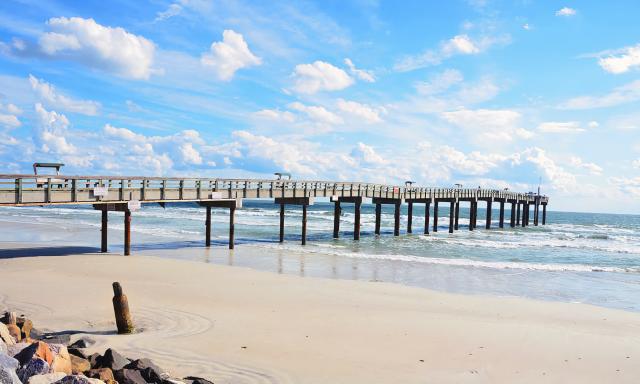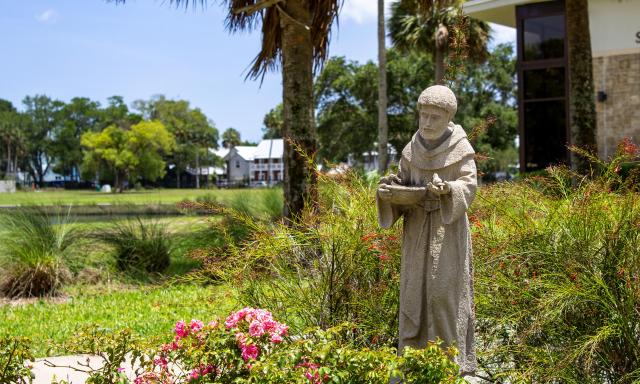Solvitur ambulando. It is a Latin phrase with a simple meaning: “It is solved by walking.”
There is nothing quite as easy, relaxing, and underrated as a nice walk, and the coastal town of St. Augustine, while known for its attractions, museums, restaurants, and shopping districts, offers wonderful opportunites to stroll, amble, and power walk. The city’s architecture and scenery are astounding, and visitors marvel at the European feel of its city streets. The surrounding geography includes pine forests with palm trees and hanging Spanish moss and sandy beaches with rolling waves. There’s something about a calm, scenic walk in St. Augustine that carries more value in it than any other diversion could.
If you’re looking for a charming and picturesque stroll, then these are some amazing places to check out.
St. Augustine Beach

The St. Johns County Pier on St. Augustine Beach.
Some people spend their whole lives inland, never setting eyes on a beach, and even fewer see the Atlantic Ocean. Visitors come to Florida just to experience the ocean, and it’s a wonderful sight to behold, especially at Anastasia Island. You won’t be overwhelmed by unbearable crowds common at beaches close to large urban areas. St. Augustine Beach is set apart with long stretches of sandy dunes, the fishing pier, and rocky ocean walls, and you’ll find an array of seashells and marine life. Best of all, if you haven’t seen a Florida sunrise, this is the place to watch it. Plus, you’ll see other walkers —dog walkers, power walkers, joggers, and runners.
Walking the beach is free, though there is a nominal fee if you choose to go into Anastasia State Park or park on the beach.
Mission Nombre de Dios

The statue of St. Francis on the grounds of the Mission Nombre de Dios.
The Mission Nombre de Dios grounds are believed to be the landing site of Menéndez, where Christianity first came to America. The site carries much historical and spiritual wealth for those seeking it, but even for those who aren’t, the site’s beauty brings a feeling of peace. The special charm of this serene patch of nature so close to the city is one of the most inviting features of St. Augustine.
Ancient trees curl over the water’s edge, providing comforting shade. The wetlands extend out, touching the horizon. The Great Cross, golden and majestic, towers over the skyline. In the wooded area, you’ll find a candle-lit chapel covered in vines, that pays tribute to Our Lady of La Leche, who was revered by Catholic natives as an intercessory icon of fertility. Walkways weave through an old cemetery ground that is considered sacred. Despite this, death is not the overpowering feeling of this picturesque trail, but rather, the beauty of life.
Walking the Mission grounds is free, and donations are appreciated to maintain the grounds.
The Bayfront

The Matanzas River at sunrise, viewed from the walk along the bayfront.
It’s hard to pick a time of the day when the bayfront is most picturesque, as it always seems to offer an unbeatable view. Even when the weather is dreary or unpleasant, the force of the waves in the bay is an incredible thing to behold. Sunrise, sunset, nighttime and noon – walking the bayfront wall is incredible. It’s empowering when you climb the steps onto the bayfront wall, and stand lifted up against the cityscape, overlooking the water – a flock of sailboats, the Renaissance-inspired Bridge of Lions, the Castillo, the island, and the lighthouse all in view. It stretches from the headquarters for the Florida National Guard, north to the Castillo de San Marcos National Monument. Whether it’s the glowing sunrise or the reflection of city lights off the water at night, there’s never a dull sight when walking the bayfront.
Walking the bayfront is free, though parking near the bayfront wall is metered.
St. George Street, Aviles Street, and Historic Downtown

Visitors stroll along St. George Street in historic downtown.
Walking around downtown St. Augustine, you’ll find our “skyscrapers” are church domes and historical spires. Our city noise is the sound of horse hoofs and trolley bells. Fast food means getting home-cooked baked goods from a local counter. This city is built around and among lush greenery, with balconies and vines setting the mood. St. George Street is where the hustle, bustle, and beauty of downtown converge. Crossing over Cathedral Place and King Street, you’ll see the town square with its towering oaks. Further, into the shopping district towards Hypolita, you’ll see palm trees shading businesses, and tiny malls filled with a multitude of tiny shops selling clothing, wines, cigars, housewares, books, and souvenirs. The energy of St. George Street and the historical sites all make for an invigorating walk. If you want to enjoy the street without the crowds, consider strolling St. George Street at sunrise. A walk around downtown St. Augustine is the way a walk around town should be — easy to navigate and pleasing to the eye.
Walking St. George Street is free, parking may not be.
Aviles Street has undergone an amazing transformation over the past few years, especially with the ever-growing popularity of the First Friday Art Walk (pictured in the cover photo). Walk through art galleries displaying the diverse talents of local artists. International restaurants and wine bars with comfortable outdoor seating are popular spots for people-watching because of the amount of foot traffic that goes through this district. Antique shops stand with window displays filled with treasures from the past, tucked into courtyards and behind scrolled gates. Further down, you’ll see Victorian-style bed and breakfasts covered with exotic flowers common in Florida — orange blossoms, bougainvillea, azaleas, lilies, and irises. Aviles Street is like a page pulled from the loveliest towns in Europe. Treading on brick and stone roads and between coquina walls will have you feeling like you’ve walked into another country.
Walking around Aviles Street is free, parking may not be.
Lincolnville

You’ll pass Lincolnville’s historic marker on a stroll around the neighborhood.
Just a few blocks south of St. Augustine’s Historic Downtown, the Lincolnville neighborhood offers a quiet walk, on tree-lined streets.
Lincolnville spans 45 blocks on the southwest peninsula of the “nation’s oldest city.” Established by freed men after the American Civil War, it was designated as an historic district in 1991 and listed on the National Register of Historic Places. Homes in the district range from charming bungalows to imposing Victorians, to newly built modern designs that complement the surrounding architecture.
This eclectic neighborhood of homes, businesses, churches, parks, and museums, includes a self-guided walking tour highlighting the homes of those who were involved in the Civil Rights Movement in St. Augustine.
St. Augustine is truly a walkable city — from the Uptown District north of St. George Street, to the Robert B. Hayling Freedom Park at the end of Riberia Street in Lincolnville. Visitors and locals continue to discover blocks and blocks of streets with elegant views, historic homes, and secret gardens. When you add the 42 miles of beaches and all the city, county, and state parks, you’ll find that there are a plethora of reasons to practice Solvitur ambulando in America’s Oldest City.

